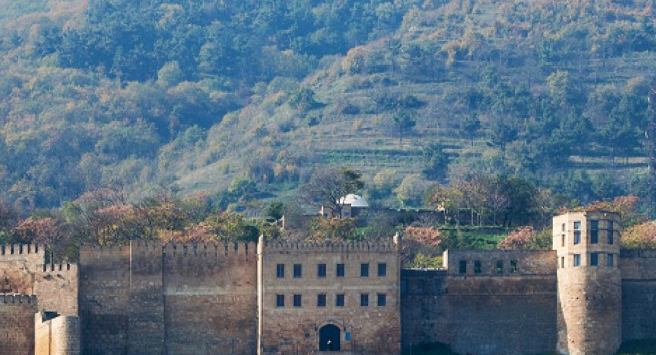
Attack in Dagestan Undermines Claims That Republic Is Stable
Publication: Eurasia Daily Monitor Volume: 13 Issue: 1
By:

On December 29, unidentified individuals carried out an attack at the Naryn-Kala fortress, a well-known tourist site in Derbent, Dagestan, killing a Russian border guard officer and injuring 11 other people (Lifenews.ru, December 30, 2015). The slain border guard officer was identified as Semyon Sporyshev. According to the police, the attackers first threw two hand grenades at a group of people who were visiting the fortress and then started shooting at them. The Naryn-Kala fortress is situated within the Derbent city limits, close to the republic’s foothills, and the attackers used one of the hills near the fortress to launch the attack, after which they retreated into a forest. An initial investigation found that two or three members of Dagestan’s Yuzhnaya (Southern) insurgent group staged the attack. The group’s leader is Abutdin Khanmagomedov, a 30-year-old who joined the underground movement in the North Caucasus in 2013. In the summer of 2015, the group reportedly pledged allegiance to the Islamic State (Onkavkaz.com, December 30, 2015). According to the Lifenews news agency, which is close to the Russian security services, Khanmagomedov himself, along with 33-year-old Rajab Ismailov and 22-year-old Nariman Bashirov, took part in the attack (YouTube, December 30, 2015).
The city of Derbent is located in southern Dagestan, near the Russian-Azerbaijani border. The city’s population is ethnically mixed, its two largest ethnic groups being Lezgins and Azerbaijanis. Before the latest attack, the city was not known as a particularly insecure place in the republic. What also makes this attack stand out is the fact that tourists were targeted, even though some of the victims were Russian servicemen. Although Dagestan has been plagued by an insurgency for years, the insurgents have rarely, if ever, deliberately targeted civilians, focusing instead on government officials, military and police. Civilian targets were almost always “ideological,” such as fortunetellers, healers and alcohol sellers.
The Islamic State quickly claimed responsibility for the attack in Derbent, using the Telegram app. Previous Islamic State claims of responsibility for attacks have been dismissed by local observers (BBC News—Russian service, December 31, 2015). In the claim made via Telegram, insurgents affiliated with the Islamic State said the attack was directed against the Russian military and that the civilians affected were injured by accident. According to the statement, the attackers retreated to their base without losses (Kavkazsky Uzel, December 30, 2015).
Despite the Islamic State claim, the authorship of the attack is not completely clear, given that an earlier Islamic State claim of responsibility for an attack in Dagestan’s Magaramkent district was dismissed by local residents and the authorities. “People get into conflict with the system, the existing order, which they do not accept,” commented the well-known Russian Muslim analyst Geidar Jemal. “Then they say that they support the Islamic State because it is something popular now. Then they act. However, tying them all up to the Islamic State is totally wrong.” Instead, according to Jemal, groups and individuals who are disgruntled by the social reality simply regard the Islamic State as a recognizable “brand” that they adopt as a “franchise” to achieve their own goals. According to Aleksei Malashenko, a Carnegie Moscow Center expert on Islam in Russia, the attack was probably a response to a lengthy interview that the governor of Dagestan, Ramazan Abdulatipov, gave to the Russian newspaper Vedomosti earlier in December, in which he claimed that the security situation in the republic was steadily improving (Kavkazsky Uzel, December 30, 2015).
In that interview, Abdulatipov said that 643 Dagestanis joined the Islamic State in the Middle East, while another 67 insurgents returned to civilian life in 2015. Further, the governor of Dagestan claimed that “very few extremists and members of the terrorist underground movement” are left in the republic (Vedomosti, December 24, 2015). Following the Derbent attack, Abdulatipov remained quite dismissive of the insurgents. “It must be an outburst by some of the remnants of bandit groups or those militants who have survived and continued to take revenge for the peace and tranquility that residents in Derbent enjoy. They [residents of Derbent] stroll in the evening, the streets are lit up, people are in a holiday mood, and there obviously were some who wanted to spoil that” (Novaya Gazeta, December 30, 2015).
Meanwhile, some experts say government policies in Dagestan may be contributing to the destabilization of the republic. By the end of 2015, the republican authorities adopted a much more forceful set of policies against Dagestan’s Salafist community, including closing down Salafist mosques, regular police checkups of the Salafis, and attempts to replace their leaders forcibly. Although the frequency of attacks in Dagestan decreased in 2015, according to observers, the conditions that could worsen the security situation in the republic persist (Svoboda.org, December 30, 2015).
Some Dagestani experts warn that the Russian government’s much advertised import substitution strategy, according to which the North Caucasus should become a major destination for Russian tourists following the rupture in Russian-Turkish relations and the suspension of flights to Egypt, is an ill-conceived idea (Kavkazskaya Politika, January 1, 2016). Given that the unusual attack in Derbent included civilian targets, the next phase of destabilization in Dagestan may take especially virulent forms. The continuing economic crisis in Russia affects impoverished regions like Dagestan particularly badly, further increasing the security risks in the republic and making it an unlikely candidate to replace Turkey and Egypt as a major destination for Russian tourists.




